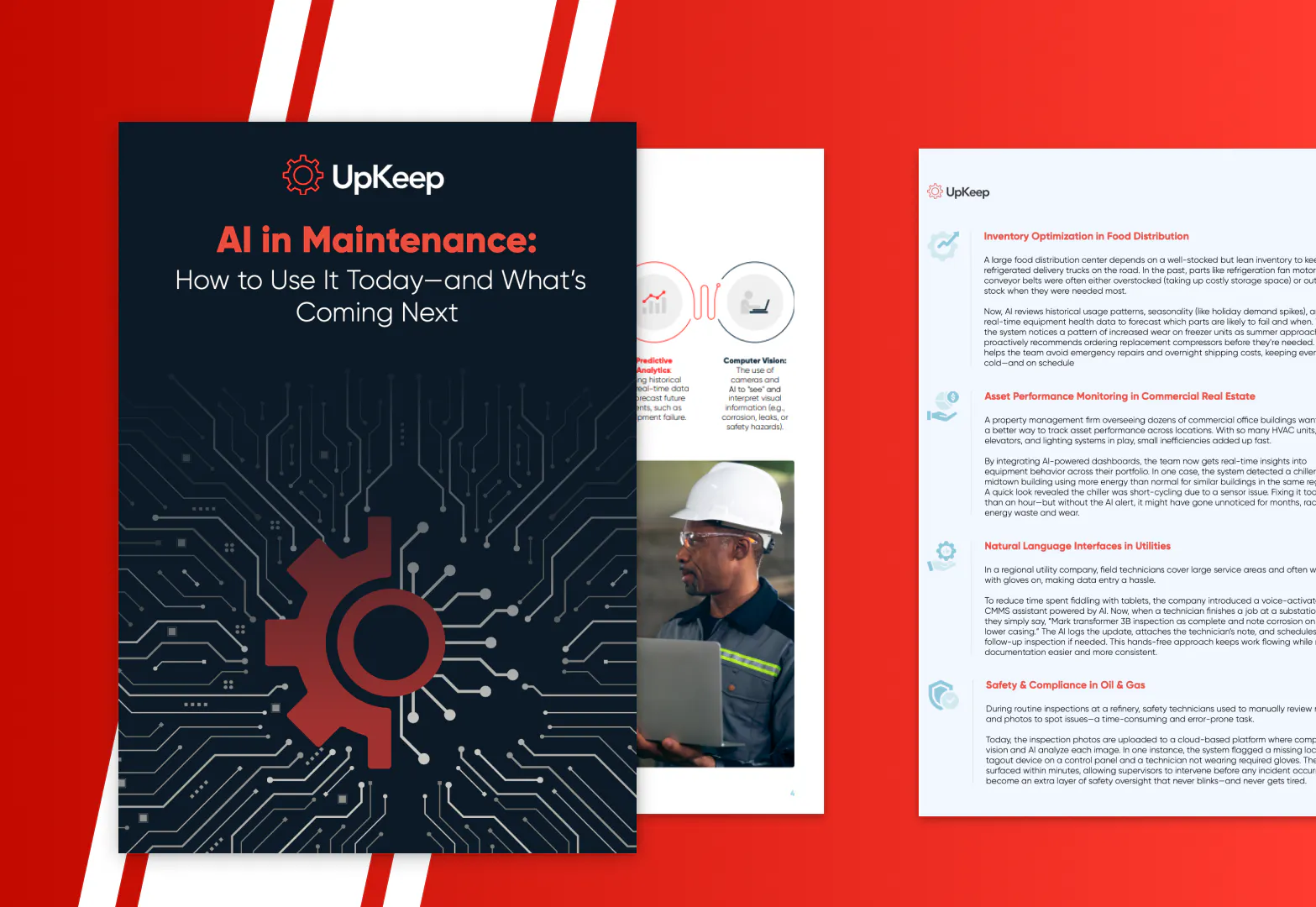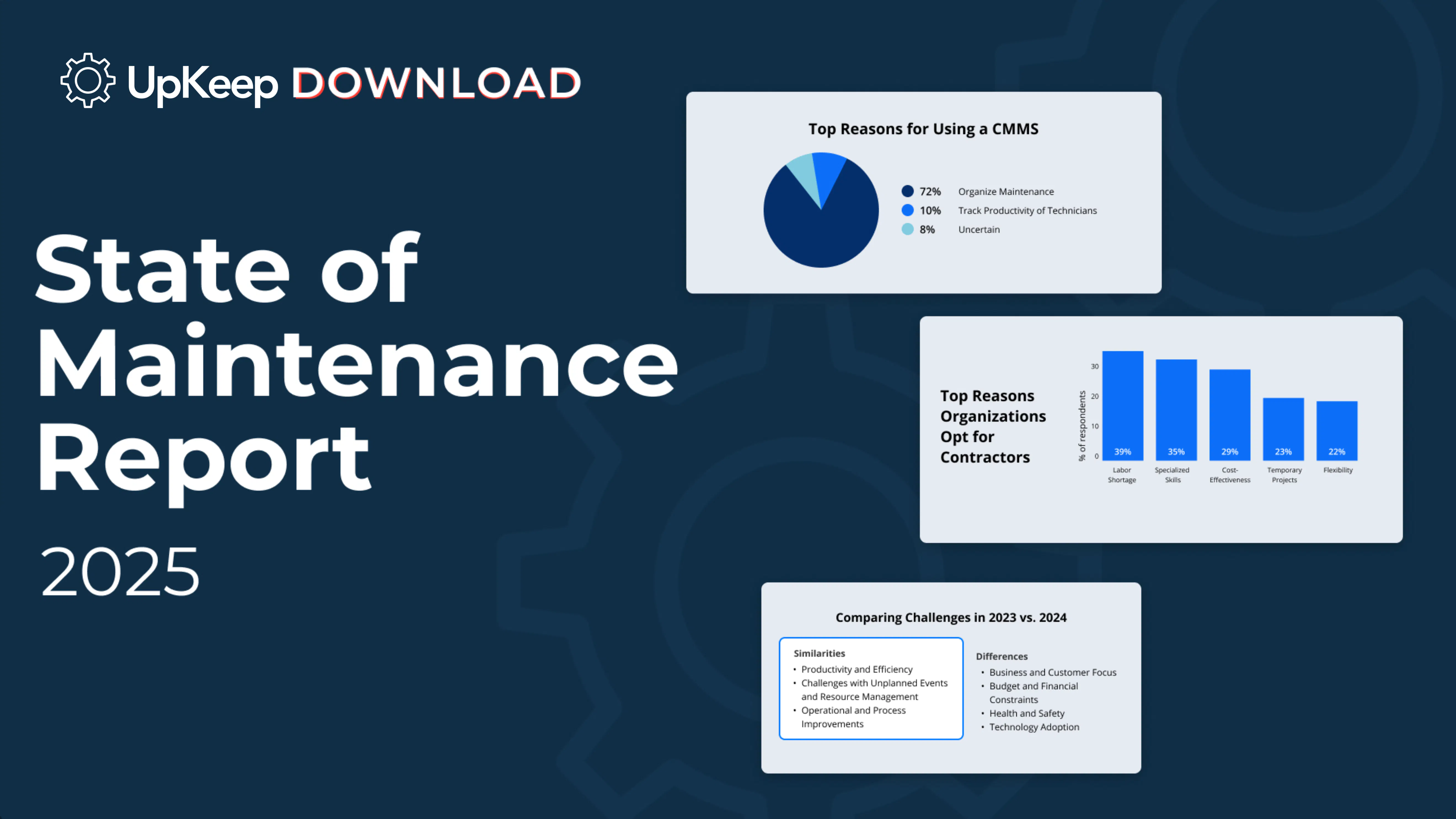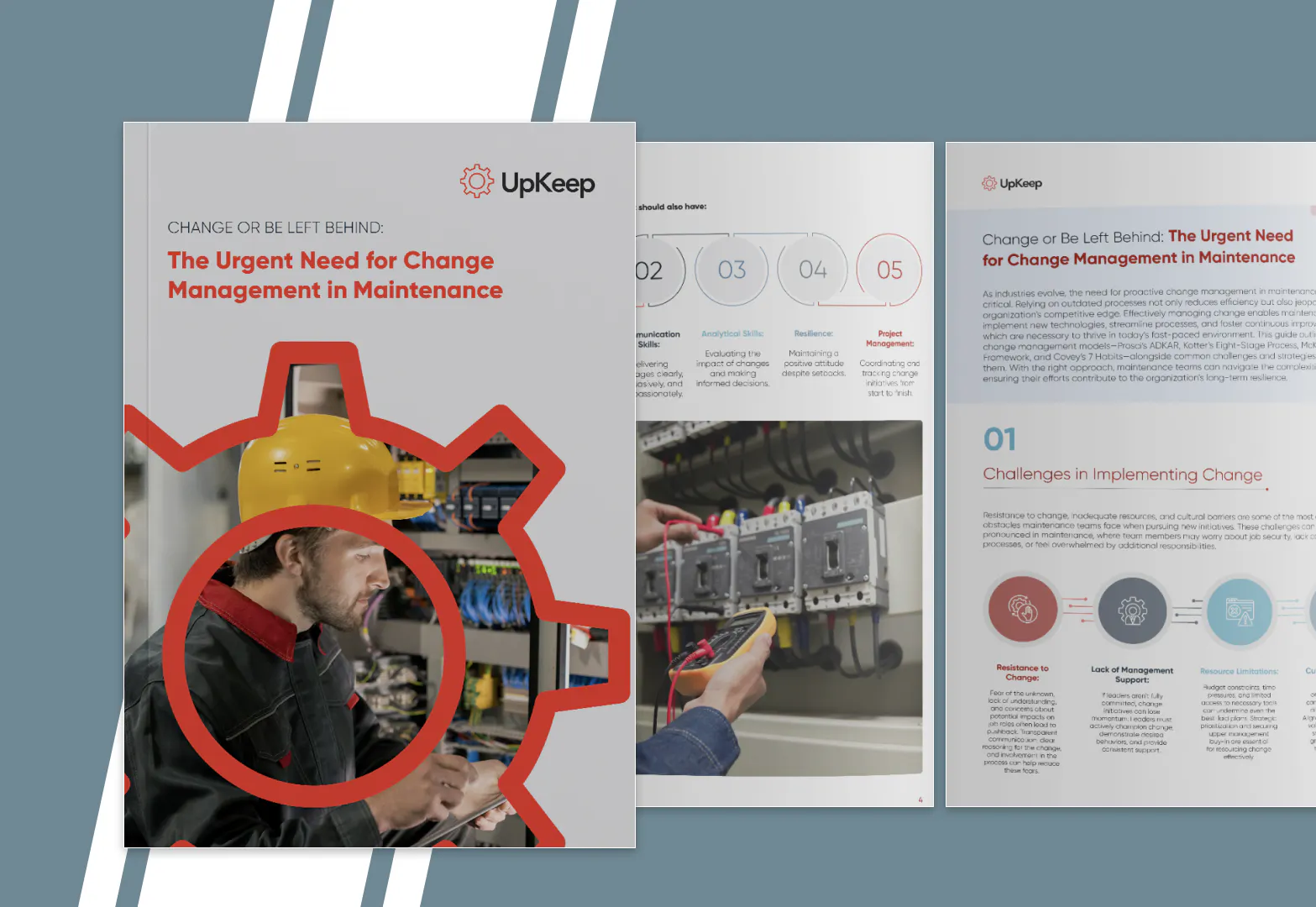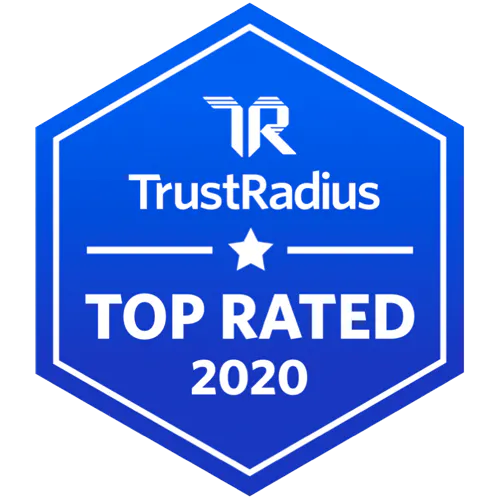Download
Essential Tips for Optimizing Your Preventive Maintenance
In this whitepaper, we’ll discuss the objectives of preventive maintenance, how to evaluate your preventive maintenance practices, and what steps to take to conduct preventive maintenance optimization.
Unlock Your All Access Pass
The purpose of preventive maintenance is to keep equipment running and functioning to specification. If it doesn’t accomplish that, then some changes need to be made. After all, the definition of insanity is “performing preventive maintenance on equipment that continues to break down.”
What Is Preventive Maintenance?
Preventive maintenance includes any actions taken to keep, preserve, and protect capacity through a disciplined process. It’s something of a controlled experiment—you put equipment into a controlled state, and you do things to it. Ideally, you should reap the same results each time.
The activities performed in preventive maintenance include both operator checks and planned maintenance tasks.
Operator Checks
There are many ways to have operators perform checks on your equipment, but the key is to make sure they’re engaged in the process.
Rather than have maintenance technicians perform all equipment inspections, have operators take on some of the simpler checks, mainly those that don’t require them to have a tool in their hand. Operators are already around the equipment, so having them check simple issues like belt deflection or temperature can save on maintenance labor hours.
Maintenance PMs
Planned tasks performed by your maintenance technicians—or PMs—include regular inspections, such as checking on pumps or chain drives. These tasks should meet the objective of keeping equipment running to desired specifications.
Gauging the Effectiveness of Preventive Maintenance
When gauging the effectiveness of each of these types of activities, remember the definition of preventive maintenance and find answers to these questions:
Do these activities meet the objective outlined in the definition?
Do they keep, preserve, and protect capacity through a disciplined process?
Do they yield the same results each time?
If they don’t accomplish this, why not?
What ideas do you have on how to achieve this goal?
These questions can give you a foundation for optimizing your preventive maintenance processes.
Getting Started with Preventive Maintenance
If you’re currently not performing preventive maintenance, the best thing to do is to start. Begin by getting equipment running the way it should. If it’s not running on its own, there’s no point performing preventive maintenance on it.
Take the example of an antique car. If you have an old ’67 Chevelle sitting in a junkyard, the first thing you have to do is restore it. Until it’s doing more than just sputtering along, preventive maintenance will offer no benefits.
[alert type="success" icon-size="normal"]Tip: When starting with preventive maintenance, choose one of your worst assets and get it running properly again. Then start planning preventive maintenance tasks from there.[/alert]
What Does Preventive Maintenance and Continuous Improvement Look Like?
Preventive maintenance optimization is a key component of continuous improvement. But what does that process look like?
Preventive Maintenance Tasks
The process of preventive maintenance and continuous improvement starts with the following steps:
Preventive maintenance tasks are planned and scheduled
The preventive maintenance tasks are executed
Results from preventive maintenance tasks are collected
Preventive Maintenance Results and Corrective Action
From there, if no problems are detected with the equipment, the preventive maintenance work order is closed out. On the other hand, if there is an issue with the equipment, these steps are followed:
A corrective work order is written based on the findings in the preventive maintenance task
The corrective work order is planned and scheduled
Corrective work is executed to specifications
The work order is closed out
Reviewing the Results of Preventive Maintenance Tasks
Once the work order is closed, it goes into metrics. The results are reviewed, and you’re able to see how effective your preventive maintenance efforts are. Some of the metrics you might look at include:
Preventive maintenance cost
Preventive maintenance compliance (within 20% of the timeframe is typically considered compliant)
Maintenance costs as a percentage of replacement asset value (RAV)
Preventive maintenance labor hours versus emergency labor hours
Evaluation and Improvement
Once these metrics are reviewed, that data goes back into the preventive maintenance tasks being planned and scheduled. If there appears to be anything that needs changing, it should be marked and sent to your maintenance planner for review. They’ll look over it with the supervisor to determine whether any changes are needed.
Proactive Maintenance and Continuous Improvement Loop
Proactive maintenance and continuous improvement create a loop. That cycle goes something like this:
Work identification, ideally from preventive maintenance, predictive maintenance, and operator care.
Maintenance planning, again from preventive maintenance, predictive maintenance, and operator care.
Maintenance scheduling, measured by schedule compliance.
Work execution to specifications following repeatable procedures. Measured by rework.
Work orders are closed out and all codes and information are put into the CMMS.
FRACAS (Failure Reporting, Analysis, and Corrective Action System): work orders are reviewed monthly for corrective action based on cost.
[alert type="success" icon-size="normal"]Tip: When verifying that all work orders are closed out accurately, pull a sample of them from your CMMS each day and make sure the codes are right.[/alert]
It’s important to make sure you don’t skip any steps in this process. In the words of Ron Thomas from Dofasco Steel, “If a step in a process is skipped or performed at a substandard level, it creates defects known as failures. The output of a healthy reliability process is optimal reliability at optimal cost.”
Preventive Maintenance Problems and Solutions
Again, insanity may be defined as performing preventative maintenance on equipment that continues to break down. The following common activities demonstrate potential problems that may arise in preventive maintenance along with possible solutions.
Inspections
Inspections are often measured based on preventive maintenance effectiveness. One metric that can be used here is MTBF (Mean Time Between Failures).
Common problems that arise from inspections include:
Preventive maintenance tasks aren’t focused on failure modes (or the ways things fail)
Ineffective measurements (measuring the wrong thing)
No step-by-step procedures
No verification that preventive maintenance tasks were completed to specifications
Personnel not following procedures
Some possible solutions include:
Engage maintenance technicians in evaluating preventive maintenance tasks
Post a line graph of preventive maintenance labor hours versus emergency or urgent labor hours
Lubrication
Lubrication in preventive maintenance can be measured with preventive maintenance compliance. Possible problems in lubrication include:
Measurements with high variation
Lack of training in best practices
No oversight from maintenance leadership
To resolve these problems, try the following:
Determine the type and amount of grease required (how many shots, how much is in each shot)
Inspect lubrication processes
Time-Based Change Outs
Time-based change outs are measured with schedule compliance. This metric should be measured by day and by hour. Problems that may arise from time based change-outs include:
Asset unavailability (often with production having you reschedule)
Ineffective maintenance planning and scheduling
In terms of solutions for this one, planning and scheduling training is key for planners and leadership
Operator Care
The effectiveness of operator care is measured through preventive maintenance compliance by shift. Preventive maintenance effectiveness may also be used. Possible problems include:
No preventive maintenance specification
Lack of reporting for corrective action
Lack of management support
Possible solutions include measuring the effectiveness of preventive maintenance compliance of operator care.
Common Preventive Maintenance Traps to Avoid
Along with common problems encountered in specific types of preventive maintenance, there are a number of pitfalls as well. Some of the most common preventive maintenance traps include the following:
Most preventive maintenance tasks are not based on failure modes.
Not enough detail in the tasks to add value.
Too many wrong tasks specified, resulting in preventive maintenance not being performed at all.
Asset unavailability during preventive maintenance outweighs reliability gains.
Lack of management focus, preventive maintenance often viewed as low priority.
Widespread dependence upon inappropriate vendor suggestions (those who sell you parts).
Example of a Preventive Maintenance Procedure
Preventive maintenance procedures are critical, so they need to be done well. The key is to make them simple, but with enough information to make them repeatable.
A preventive maintenance procedure should list the following:
The equipment block ID
Equipment hierarchy
Project description (a one-line description of what needs to be done)
Frequency (weekly, monthly, annually)
Estimated craft hours (number of technicians times the number of hours)
Estimated elapsed time (how long the project will take to complete)
Estimated production downtime (how long the production line will be down)
Procedure originator, origination date, owner, and so on
Warnings and cautions
Personal protective equipment
Part ID numbers and descriptions along with quantity
Any consumables, special tools, and equipment required
Required department coordination
Other procedures referenced (such as required shutdown)
Steps to completing the project with space for the craftsperson’s initials
Condition as found
Condition as left
Comments and findings
Craft’s feedback on the procedure
Crafts’ signatures and the date
These details help make the process more efficient. For example, including part IDs can let the maintenance planner know to pull specific parts and have them kitted for technicians to use when they go do the job. Step-by-step instructions give technicians clarification on how to complete the job, while asking for their initials helps keep them accountable.
Measuring Preventive Maintenance
“If you can’t measure it, you can’t manage it” (Peter Drucker). How does your company currently measure the effectiveness of your preventive maintenance program? Common methods and measurements include:
Monthly audits
Completion percentages for preventive maintenance
Preventive maintenance versus emergency maintenance hours (ideally 6 to 1)
From there, it’s important to consider how you know if your current preventive maintenance program is effective or not. One metric you could use in this area is the number of hours spent on preventive maintenance versus spend on reactive work orders.
Leading vs. Lagging KPIs
The key performance indicators (KPIs) you’ll use when measuring your preventive maintenance process come in two varieties:
Leading KPIs, which lead to results
Lagging KPIs, which are the results
Leading KPIs include:
Preventive maintenance compliance
Percentage of preventive maintenance with step-by-step instructions
Percentage of preventive maintenance evaluated monthly
Number of defects found
Lagging KPIs for preventive maintenance include:
OEE (overall equipment effectiveness)
Maintenance material costs
Maintenance overtime
Rework
Fundamentals of Effective Preventive Maintenance
To start gauging your preventive maintenance tasks, compare your process with these recommendations:
All equipment preventive maintenance is focused on specific failure modes (including those for environmental issues like spills).
All preventive maintenance should have step-by-step instructions, specifications, and extra space to record the condition as found/as left, recommended changes to procedure, etc.
Equipment failure histories should be attached to all preventive maintenance tasks.
Root cause analysis should be initiated if equipment fails between preventive maintenance cycles.
In the shop, display a line graph of preventive maintenance labor hours versus emergency labor hours.
The final point works on the fact that people change behavior when they are shown their performance. If they see how their preventive maintenance labor hours compare with time spent on emergencies, there’s a higher chance of improvement.
What to Do If Preventive Maintenance Is Not Meeting Expectations
Whenever you find that your preventive maintenance is not meeting expectations, the following steps should help you get on track.
1. Acknowledge You Have a Problem With Your Preventive Maintenance Program
As with any problem, the first step is admitting you have one. If it appears that parts fail too often, preventive maintenance is deferred too frequently, production is lost, and so forth, those would constitute problems.
[alert type="success" icon-size="normal"]Tip: It may be necessary to reassess how you define equipment failure. It doesn’t always mean the machine is broken. Today’s definition of failure is when equipment simply doesn’t perform its intended function.[/alert]
2. Assemble a Preventive Maintenance Optimization Team
Your preventive maintenance optimization team should consist of maintenance technicians, a maintenance supervisor, and operators. It’s best to select proactive maintenance techs for the team. The attributes of a proactive technician are:
Ensures all maintenance work is executed to specifications.
Performs preventive maintenance as a controlled experiment.
Always seeks to advance their technical knowledge.
Always performs corrective work after creating a work order.
Arrives at work 100% on time.
Notifies supervisor of problems immediately.
3. The Team Establishes Their Vision, Mission, and Guiding Principles
Once assembled, your team should establish their vision, mission, and guiding principles. They should also meet weekly for 30 minutes max. That way, they’re not taking people’s time.
An example of a vision statement might be: “Preventive maintenance will meet the intent of the stockholders of our company through a disciplined approach in execution, management, and measurements.”
A mission statement might look like this: “Preventive maintenance will be conducted as a controlled experiment resulting in optimal asset reliability at optimal costs, enabling optimal process reliability.”
Guiding principles might include the following:
Preventive maintenance is the most important routine function that maintenance personnel must accomplish.
Preventive maintenance must meet the expectations of production.
Our preventive maintenance must be measured using the right leading and lagging KPIs.
Preventive maintenance must be evaluated for effectiveness if equipment failures are occurring.
Maintenance technicians are involved in preventive maintenance evaluation and optimization.
With respect to the last point, while reliability engineers can facilitate, maintenance technicians should be at the forefront of preventive maintenance optimization.
4. Identify the Equipment That Has the Most Losses
Next, identify the equipment that has seen the most losses in terms of OEE, production loss, emergency/urgent labor hours, and so forth.
5. Post a Dashboard to Measure the Program’s Progress and Effectiveness
After selecting equipment to monitor, you’ll want to measure your program’s progress and effectiveness. Putting it in a dashboard makes it visible, increasing the odds of sustained change.
6. Create a Preventive Maintenance Problem and Solution Board
Finally, create a preventive maintenance problem and solution board with causes, solutions, and ways to measure and sustain your results.
Top 4 Reasons You May Want to Conduct a Preventive Maintenance Evaluation
The top four reasons to conduct a preventive maintenance evaluation are the following.
1. Never Thought About the Impact a Evaluation Would Make
Reason number one to conduct a preventive maintenance evaluation is if you’ve never considered the impact it could have on equipment problems and failures, production throughput, and so on.
2. Free Up Maintenance Staff to Perform Proactive Work
Reason number two is to free up your staff to perform proactive maintenance. If you’ve noticed that wrench time is low, an evaluation can help you determine how to increase it. Breakdowns take away time to conduct preventive and corrective maintenance, and they can negatively impact planning and scheduling.
3. Take Operator Care to the Next Level
The next reason is to improve operator care. You can help operators take pride in operating the equipment while reducing their stress levels. At the same time, you’ll minimize process and asset failure, ultimately reducing costs.
4. Reduce Costs
It all comes down to reducing costs in your plant or site. Doing so ensures the viability of your facility.
Step-by-Step Preventive Maintenance Optimization
When it comes to actually conducting preventive maintenance optimization, the following step-by-step process can help:
1. Identify an Area to Evaluate Preventive Maintenance Tasks
First, identify an area where you need to evaluate your preventive maintenance tasks. Consider where you have the biggest problems or the most concerns. A good place to start is where operators are complaining the most.
The point here is to focus. You don’t necessarily want to evaluate all of your preventive maintenance, just the ones that matter most. This also acts as a proof of concept to leaders to prove preventive maintenance optimization works.
2. Identify a Cross-Functional Team
Next, create a team. Make sure you get an operator who works on a machine in the area being optimized. In addition, include maintenance technicians, a reliability engineer, a maintenance supervisor, and your maintenance planner. Your maintenance planner will be crucial since they have access to key information like the equipment’s history.
3. Identify Roles and Responsibilities
The third step is to identify the roles and responsibilities of everyone involved in the preventive maintenance optimization process. If you’re going to do a preventive optimization process, everyone has to know their stake in the game. Fortunately, this is fairly simple to do. Just follow these steps:
Identify the preventive maintenance optimization process
Identify cross-functional stakeholders (managers, supervisors, technicians, engineers, CMMS administrators, etc.)
Identify stakeholder expectations
Define the end goal
Determine how to measure preventive maintenance effectiveness
Review equipment history for the past 30, 60, and 90 days
Review preventive maintenance by task/steps and make changes/reassignments as needed
Create and measure preventive maintenance effectiveness with a scorecard
Modify and write preventive maintenance tasks and measure the results
4. Establish Expectations from Everyone Engaged in the Process
Once everyone knows their roles and responsibilities, establish expectations from everyone involved. They may say they want things to run better, get machines running all the time, etc. The main point is to engage them in the process by asking them what they expect.
5. Define the End Goal of the Process
With everyone’s expectations in mind, define the end goal of your PM optimization process. For example, you might decide that you want the overall equipment effectiveness (OEE) up to a certain rate.
6. Define How You Will Measure Effectiveness
Having defined your end goal, determine how you’ll measure whether your PM optimization is effective or not. Define the metrics you’ll measure. They may be the same as what you’re measuring already, or you might need to make changes.
7. Present Copies of PMs to Each Person
Next, it’s time to review your preventive maintenance tasks. Present all copies of relevant PMs to each person on your team.
8. Review Equipment’s History
With copies of the PMs in everyone’s hands, review the equipment’s history for the past 30, 60, and 180 days. Look in particular at the number of breakdowns, the causes of critical breakdowns based on formal RCA, and PM labor hours.
Tip: If you’re not currently measuring the above metrics, start.
9. Review Current PMs and PdM Tasks
The next step is to review current PMs and predictive maintenance (PdM) tasks. In particular, you want to determine the following:
Whether PMs need to be rewritten
Training that may be required
Inaccurate PM frequencies and need for adjustments
Whether the equipment is even in maintainable condition
10. Rewrite PMs or Write New PMs
If your current PMs have issues, they may need rewriting. In some cases, you may need to write entirely new ones.
11. Monitor and Measure
Finally, monitor and measure to see if your new PMs are effective or not. Make adjustments as the need arises.
Example of Preventive Maintenance Optimization Results
As you collect the results of your preventive maintenance evaluation, you might organize them into a chart. List the types of recommended actions that should be taken. For instance, some actions you might take for a given preventive maintenance task include:
Delete (doesn’t add value)
Reassign to operator care
Reassign to lube route (technicians can do routine inspections while lubricating equipment)
Replace with predictive maintenance (especially if a predictive maintenance technician is already looking at it)
Reengineer (modify or rewrite the preventive maintenance task)
No modification required
For each action, identify the number of tasks it represents as well as its percentage of total tasks. With that information, determine the labor hours that are represented.
Conclusion
By carefully analyzing your preventive maintenance tasks, you can optimize your maintenance processes and bring them into better alignment with best practices. Doing so will ensure that:
Your equipment meets capacity, quality, and cost requirements.
You keep equipment in maintainable condition.
You prevent equipment failure when run-to-failure is not your maintenance strategy.
You meet production requirements through optimization of asset reliability.
In the end, it’s all about production. Preventive maintenance optimization helps you reliably deliver assets to production.
Want to keep reading?

Maintenance
AI in Maintenance: How to Use It Today—and What’s Coming Next

Maintenance
State of Maintenance Report 2025

Maintenance
Change or Be Left Behind: The Urgent Need for Change Management in Maintenance
4,000+ Companies Rely on UpKeep's Asset Operations Management Software




